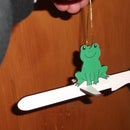Introduction: Celebrate Hunting Success With a Stencil
A previous Instructable covered building a case for a rodent trap to prevent any native wildlife being harmed.
This has worked in that no small birds or giant weta have been caught, and after a bit of a drought the first rat has been sent to meet the Death of Rats.
To celebrate, I decided to maintain a tally of victories by spray-painting a rat silhouette on the side of the trap for each pest killed.
Step 1: Print and Cut Paper
A google search for "clip art rat silhouette" produced a lot of responses.
Since I was going to be cutting the stencil by hand, I opted for a fairly simple picture, and since the image was to be applied to rough-sawn timber with a spray can, I picked one which had a fairly thick tail.
The image above was downloaded from "FlatIcon.com" and is usable if attributed. It's a great site, and I both attribute and recommend it (no connection other than as a freebie downloader).
The image was printed onto ordinary thin paper, and as can be seen from the first photograph above, the printer was fairly poor quality. This doesn't matter as the image is only to guide the cut.
I used a new blade section in a box cutter and cut around the outline by hand. This was surprisingly easy (see error section) and only took ten minutes.
Step 2: Strongback Cardboard
To support the stencil in use and in storage, it was mounted onto some thick cardboard. A the board from a cereal packet would be ideal, but since I only had corrugated cardboard I used that.
The discarded piece which had been cut out in the previous section was held against the cardboard using some trips of Post-It (other sticky notes are available) and marked around with a felt-tip pen. The key here is to have the hole in the cardboard bigger than the precisely cut hole in the paper.
The paper was attached to the face of the cardboard with double-sided tape.
The last photograph above shows the front of the stencil, with a thin band of white paper visible all around the cut-out.
Step 3: Application
Literally, what it says on the tin.
Shake well, hold the stencil so that the accurately cut paper is hard against the substrate and let it have it.
Actually, not quite what it says on the tin, as it suggests holding the can much further way from the target than I did. Had I followed the instructions precisely, then I would have regretted not wearing a glove on the hand holding the stencil.
Step 4: Correcting Mistakes
Going around the shoulder of the rat I got a bit overconfident and drifted off the line. A short bit of sticky-tape held the pieces back together, and also meant that there was a bit more structural integrity around that area of the rat when I was re-cutting on the correct line.
When cutting around a tight radius of curvature at the base of the tail, the paper began to tear. Again, a patch of sticky-tape fixed the paper and provided enough strength to the paper for me to re-cut the line.
Cutting the little pointy bits for the claws was difficult, as they were so fine that the paper rucked up with each cut. This could be avoided by covering the area with tape before cutting, but I just used a downward push on the knife blade in this area rather than a dragging cut.
Basically, cover the whole line with sticky-tape before cutting and all will be fine.






